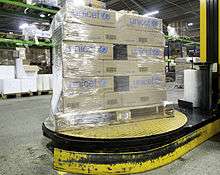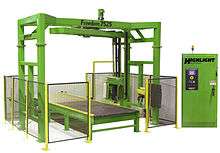Stretch wrap

Stretch wrap or stretch film is a highly stretchable plastic film that is wrapped around items. The elastic recovery keeps the items tightly bound. In contrast, shrink wrap is applied loosely around an item and shrinks tightly with heat.
It is frequently used to unitize pallet loads but also may be used for bundling smaller items. Types of stretch film include bundling stretch film, hand stretch film, extended core stretch film, machine stretch film and static dissipative film.
Materials
The most common stretch wrap material linear low-density polyethylene or LLDPE, which is produced by copolymerization of ethylene with alpha-olefins, the most common of which are butene, hexene and octene. The use of higher alpha-olefins (hexene or octene) gives rise to enhanced stretch film characteristics, particularly in respect of elongation at break and puncture resistance. Other types of polyethylene and PVC can also be used. Many films have about 500% stretch at break but are only stretched to about 100 – 300% in use. Once stretched, the elastic recovery is used to keep the load tight.
There are two methods of producing stretch wrap. 1) Blown: the resin is melted and extruded through an annular die, it is air-cooled. This is a slower process but provides for higher quality in all the areas listed below. The cost of production is also higher due to the quantity that can be produced per hour. 2) Cast: the film is extruded through a slot die, then passed over cooling rollers. This makes the cooling process quick. The quality is not as good as blown but more can be produced in an hour with lower costs.
Other properties such as break strength, cling, clarity, tear resistance, static discharge, etc. are also important.
Functions
In pallet unitizing, stretch wrap can have several functions:
- improved stability of products or packages, forming a unit load
- more efficient handling and storage of unit loads
- some degree of dust and moisture protection
- some degree of tamper resistance and resistance to package pilferage
- some degree of sun protection (UV stretch wraps)
- extend shelf life of certain foods[1]
Making sure boxes stay on the pallet is an important consideration in warehouse distribution, especially as the demands for increased throughput continues to rise.
Application

Categories and sub-categories of stretch wrappers:
Manual (or Hand) Wrappers:
- Extended Core: An extension of the film's core serves as a handle for wrapping; this type of wrapper offers little stretch control and is hard on hands.
- Mechanical Brake: A simple structure supports a film roll and a mechanical brake system provides resistance creating stretch of the film.
- Pole Wrappers: Similar to the Mechanical Brake system, but the roll and brake are at the end of an extended pole, creating an ergonomic design which eliminates the need to bend to wrap the bottoms of loads and strain to reach the tops of loads. Used for space missions too.
Semi-Automatic Wrappers:
- Turntable Wrappers: The load to be wrapped sits on a turntable which spins the load relative to the film roll, which is housed in a carriage which can move up and down a fixed "mast". Stretch is achieved by rotating the load at a faster rate than the film is fed.
- Orbital Wrappers: The film is housed in a carriage on a vertical ring, the load is fed horizontally through the eye of the rotating ring, applying film to the load. A variation of an orbital stretch wrapper is a horizontal ring system, in which the load remains still while a horizontal ring is rotated around the load and moves up and down vertically relative to the load, similar to a rotary arm stretch wrapper.
- Rotary Arm Wrappers: In this system, the load remains still while a rotating arm turns around it wrapping the load. This system is used for light loads or for speeds which would otherwise cause the load to topple due to high rotation speeds.

Automatic Wrappers:

Automatic wrappers are generally a variant of a semi-automatic system. Automatic wrappers include a conveyor system to automatically load the wrapping machine and automatic systems to apply, seal, and cut the film.
- Turntable Wrappers: The load to be wrapped sits on a turntable which spins the load relative to the film roll, which is housed in a carriage which can move up and down a fixed "mast". Stretch is achieved by rotating the load at a faster rate than the film is fed.
- Rotary Arm Wrappers: In this system, the load remains still while a rotating arm turns around it wrapping the load. This system is used for light loads or for speeds which would otherwise cause the load to topple due to high rotation speeds.
- Rotary Ring Wrappers: The film is housed in a carriage on an horizontal ring in which the load remains static while the horizontal ring is rotating around the load and moves up and down vertically relative to the load, similar to a rotary arm stretch wrapper. The rotary ring technology is really a more balanced system with less wear and maintenance than the other available wrapping technologies. These wrappers are capable to reach the highest production capacities (up to 160 pallets/hour).
See also
| Wikimedia Commons has media related to Stretch Wrap. |
References
- ↑ Dahll, R K; Sharma (August 2012). "Effect of shrink wrap packaging for maintaining quality of cucumber during storage". Journal of Food Science and Technology. 49 (4): 495–499. Retrieved 9 June 2017.
Further reading
- ASTM International D4649 Guide for Selection and Use of Stretch Wrap Films
- Yam, K. L., "Encyclopedia of Packaging Technology", John Wiley & Sons, 2009, ISBN 978-0-470-08704-6